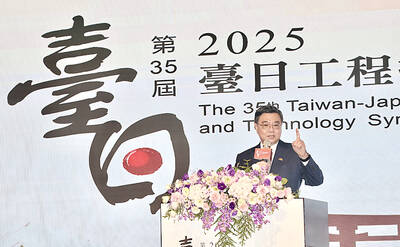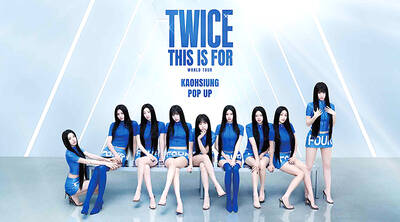Lin Li-tsai (林黎彩) was only two years old when her father was murdered. She knew almost nothing about his death until she was an adult.
“There used to be a picture of my father hanging in the living room, but I didn’t even know who it was,” said Lin, now 80.
She has no memory of the events and throughout her childhood his death was mentioned just twice. The first was when her uncle warned her: “Don’t talk about what happened to your father, otherwise the police will come get you.” The second was in elementary school when a teacher saw the date of his death on her file, and told Lin she would have to study and work very hard.

Photo: Su Fu-nan, Taipei Times
Sitting in a quiet room of a museum dedicated to people like her father, Lin is hard of hearing, but speaks confidently. As she speaks, her hands unconsciously rifle through a folder containing documents and photographs of her father.
He was a victim of the 228 Incident, a brutal crackdown on anti-government protests by troops of the Chinese Nationalist Party (KMT) government in 1947, which had been given control of Taiwan after Japan was defeated in World War II.
An estimated 18,000 to 28,000 people were killed or disappeared after anti-government protests began on Feb. 28 in Taipei and spread nationwide. Individuals were taken from their homes and workplaces and tortured, disappeared, jailed or summarily executed. It set off almost four decades of martial law known as the White Terror era.
Democratic Taiwan marks the anniversary of the Incident each year, and there are dedicated memorial museums, parks and statues.
Premier Chen Chien-jen (陳建仁) on Sunday unveiled a monument at the Executive Yuan compound, officially designating the building a “historical site of injustice.”
“It is time for us to recognize rights abuses and atrocities by past governments. By restoration and facing up to history, we can go on to sustain peace and justice for all,” Chen said.
However, a full and formal national reckoning with the Incident’s legacy remains complicated and politicized.
Lin’s family’s story is typical. On March 6, 1947, Lin Chieh (林界) and colleagues from the city council went to the Kaohsiung military office to negotiate for peace between the soldiers and protesters, but in response soldiers were sent down to city hall where they shot and threw grenades at protesters sheltering inside, killing at least 50 people, and Lin Chieh and others were detained, tortured and — about two weeks later — executed.
Lin Chieh’s brother and wife searched for days. The brother was threatened and humiliated. His wife eventually found her husband’s body under a pile of rubble in front of the office, fainting at the sight.
He was killed with impunity and his family kept their heads down during the White Terror era. The death was never discussed and eight years later, Lin Chieh’s mother took her own life.
Lin Li-tsai only learned her family’s history in the 1990s and has spent the decades since working as an advocate, seeking justice against the KMT and better understanding among the public.
Today, Lin Chieh’s execution is among dozens highlighted in new exhibitions at Taipei’s 228 Memorial Museum, one of several White Terror museums nationwide. A wall map details incidents across the south, after the protests and retaliatory crackdowns spread from Taipei. Artworks depict numerous massacres, including the grenade attack on the protesters Lin Chieh had sought to protect.
Yeh Tzung-hsin (葉宗鑫), the museum’s coordinator, says the exhibits were motivated by what they saw as gaps in formal education about the Incident, and increasingly polarized discussion of the time and its legacy.
“Online I saw that extreme speech has increased, and become more divided,” he said. “There are a lot of sites we pass by every day where executions happened. It’s important to know this.”
There are many examples around the world of transitional justice models established to deal with states’ crimes against their own people, including truth and reconciliation commissions, prosecutions, legislated restrictions on former collaborators participating in society and amnesties, but Michelle Kuo (郭怡慧), a Taiwan-based author and academic, says Taiwan has diverged from both the restorative justice model provided by South Africa and more punitive paths in eastern Europe.
“Unlike these countries, where the party wielding authoritarian power was disbanded, the KMT remains a major political party, albeit currently in opposition,” Kuo said.
Perpetrators have not been brought to justice and the truth of what happened in many cases — including the shocking 1980 murder of democracy advocate Lin I-hsiung’s (林義雄) mother and his seven-year-old twin daughters — still has not come out.
Successive governments have made some efforts to address the issue. In 1990, then-president Lee Teng-hui’s (李登輝) administration established an investigation into the Incident. Lee in 1995 formally apologized on behalf of the government and launched a redress scheme. The Democratic Progressive Party (DPP) government, which was born out of the anti-authoritarian movement, in 2016 established the Transitional Justice Commission, with powers to investigate crimes committed under KMT rule, but victims’ families have expressed frustrations with the DPP, which they say has not done enough.
Huang Cheng-yi (黃丞儀) of Academia Sinica said that the KMT offered financial compensation as a deliberate strategy to avoid truth-seeking, to give money while “refusing to talk about history,” and there is little appetite from either party to address the awkward fact that so many victims were suspected or actual supporters of the Chinese Communist Party — an entity that is now threatening Taiwan’s existence.
For Lin Li-tsai, the KMT of today is the KMT that killed her father.
The KMT has apologized for the White Terror era, but held on to its name and other parts of its past, creating what Huang calls a “paradoxical ideology.”
“They apologize for the dark side, but they want people to recognize their achievements in bringing Taiwan’s prosperity and security,” he said.
Kuo says the KMT also frequently politicizes attempts at redress.
“The KMT has insisted that it has changed ... but it also claims that transitional justice is a partisan project rather than a national one,” she wrote last week.
The hope of advocates such as Lin Li-tsai and educators like Ye, Huang and Kuo seems increasingly distant, as political divisions widen and those who lived through the White Terror era — or perpetrated its crimes — grow older.
Huang says Taiwan can reckon with its legacy of authoritarianism through real transitional justice, but it is being stymied by partisan politics and a collective “historical amnesia” in which people distance their own lives from the “others” who were directly affected by authoritarian rule, or retain the White Terror-era fear of speaking out.
“When 228 [memorializing] became a political ritual, many people believed it was no longer necessary to remember the past,” he said. “This is a crisis for our democracy... When people care less about the past, about what has been done by the authoritarian government, it means people are actually trying to pretend that we don’t have that kind of atrocity or political oppression in our history.”

The Ministry of Foreign Affairs (MOFA) yesterday voiced dissatisfaction with the Comprehensive and Progressive Agreement for Trans- Pacific Partnership (CPTPP), whose latest meeting, concluded earlier the same day, appeared not to address the country’s application. In a statement, MOFA said the CPTPP commission had "once again failed to fairly process Taiwan’s application," attributing the inaction to the bloc’s "succumbing to political pressure," without elaborating. Taiwan submitted its CPTPP application under the name "Separate Customs Territory of Taiwan, Penghu, Kinmen and Matsu" on Sept. 22, 2021 -- less than a week after China

ALIGNED THINKING: Taiwan and Japan have a mutual interest in trade, culture and engineering, and can work together for stability, Cho Jung-tai said Taiwan and Japan are two like-minded countries willing to work together to form a “safety barrier” in the Indo-Pacific region, Premier Cho Jung-tai (卓榮泰) yesterday said at the opening ceremony of the 35th Taiwan-Japan Modern Engineering and Technology Symposium in Taipei. Taiwan and Japan are close geographically and closer emotionally, he added. Citing the overflowing of a barrier lake in the Mataian River (馬太鞍溪) in September, Cho said the submersible water level sensors given by Japan during the disaster helped Taiwan monitor the lake’s water levels more accurately. Japan also provided a lot of vaccines early in the outbreak of the COVID-19 pandemic,

Kaohsiung Mayor Chen Chi-mai (陳其邁) on Monday announced light shows and themed traffic lights to welcome fans of South Korean pop group Twice to the port city. The group is to play Kaohsiung on Saturday as part of its “This Is For” world tour. It would be the group’s first performance in Taiwan since its debut 10 years ago. The all-female group consists of five South Koreans, three Japanese and Tainan’s Chou Tzu-yu (周子瑜), the first Taiwan-born and raised member of a South Korean girl group. To promote the group’s arrival, the city has been holding a series of events, including a pop-up

A home-style restaurant opened by a Taiwanese woman in Quezon City in Metro Manila has been featured in the first-ever Michelin Guide honoring exceptional restaurants in the Philippines. The restaurant, Fong Wei Wu (豐味屋), was one of 74 eateries to receive a “Michelin Selected” honor in the guide, while one restaurant received two Michelin stars, eight received one star and 25 were awarded a “Bib Gourmand.” The guide, which was limited to restaurants in Metro Manila and Cebu, was published on Oct. 30. In an interview, Feng Wei Wu’s owner and chef, Linda, said that as a restaurateur in her 60s, receiving an